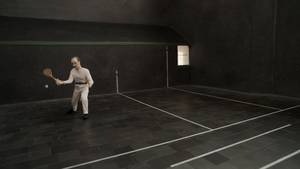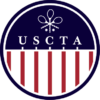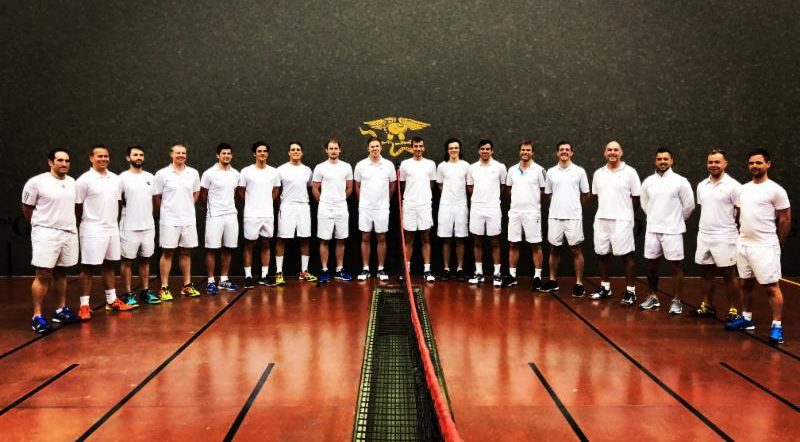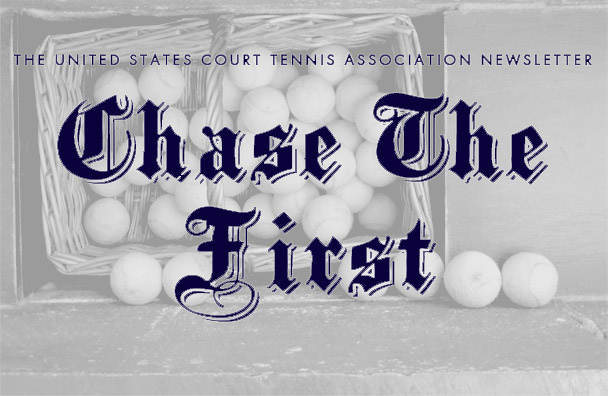Jeu de Paume 
By James Zug
One of the highlights of the inaugural International Tennis Day on 20 June will be the world tennis premiere of a new video on the game. This spring the Whitney Biennial, the nation’s most prestigious recurring exhibition, showed Joshua Mosley’s “Jeu de Paume.” It is a three-minute stop-motion animated film depicting a 1907 court tennis match at Fontainebleau. “A gem,” Andrew Russeth in the Gallerist. “Uncanny,” said Alexandria Symonds in Interview. “Interesting and fruitful,” wrote Marc Yearsley in the Gothamist.
Mosley is no stranger to major art exhibitions. He was in the 2007 Venice Biennale and has exhibited at museums around the world including the Museum of Modern Art in New York. He is currently a professor of fine arts at Penn.
On International Tennis Day, Mosley will screen the film in the racquets court at the Racquet Club of Philadelphia. You can learn more at Mosley’s website: http:// joshuamosley.com/ The film is available for purchase in a limited edition of five. See Mosley’s gallery, Corbett vs Dempsey, in Chicago: http://www.corbettvsdempsey.com/artists/joshua-mosley/
Recently, we discussed with Mosley the story behind his most unusual film.
USCTA: You’ve done animations about everything from a journey through the moon to a park ranger maintaining a gigantic sculpture to subjects like ancient Roman poets and Austrian economists. How did you get the idea to make a film about court tennis?
Joshua Mosley: I grew up in St. Louis playing competitive tennis. A friend of mine owns Egan Day, a jewelry store just down the street from the Racquet Club of Philadelphia. One day I was introduced to Ashley Virgona, Steve’s wife who worked at Egan Day. I heard about this strange sport that Steve played. It captured my imagination. I started reading about the game. I picked up Scanio’s 1555 book, the Noel & Clark from 1924. I like treatises, I like to learn why something is structured the way it is. Through Facebook, I connected to other people in the game, Haven Pell. I watched old footage of tennis. I went to the Racquet Club and watched Steve play a match. Then Rob Whitehouse gave me a lesson. I asked him a thousand questions that hour. I found the shock of the ball hitting the racquet intense.
USCTA: Tell us about how you created the film.
JM: I built a court that is about fifteen feet long. It is basically two queen-sized beds end to end. It is made of plywood, slate, paint. I can move around in it. Can’t stand up—it is about forty-five inches high. I set up a shot and then crawl out of the court or duck into a corner. The two puppets are made with silicon and have steel ball-joint armatures. I knitted up the cloth clothing from a woman’s tee-shirt.
USCTA: How did you make the sounds?
JM: I bought a racquet from the club in Boston and had them string it with real gut that I sent them, so it sounded the way it would have in 1907. Then I went to the Germantown Friends School gym very early in the morning and recorded hitting a ball with that racquet. I needed a space that was large enough that I could record the sound of the racquet hitting the ball and the ball flying through the air. You can still barely hear some of the ambient sounds of birds from that day.
USCTA: What is the story of the match?
JM: I chose to create a ficticious match. I originally thought I might have just one player. But having just one player made it kind of a cartoon.
The two are Ferdinand Garcin of France and J.B. Gribble of England. [Garcin was a well-known professional in Paris. He challenged for the world championship in 1906, losing to Punch Fairs 7-4; he also tutored a young Jay Gould. Gribble won the 1897 British amateur title.] They never played at Fontainebleau in 1907. Garcin is serving. I filmed five points, the first five points of their match.
USCTA: What is the artistic vision here?
JM: I wanted to focus on the physical space of being in a match and how tennis because of the asymmetrical court requires a certain cantilevered awareness., how you feel separated from the environment. Every court is different: acoustics, lighting, sounds, the balls, humidity, the floor. You have hit a reset about spatial awareness each time you go on court. I was thinking a lot about how your brain is focused on the competitive match but also on recalibrating these distractions. I wanted to explore that psychologically, how you could lose track of the score. There is a narrative also about the way you recollect a match that is different than the way it actually unfolded. It is just like watching this video: at some point you will forget that you are watching it: you are experiencing the film directly.
USCTA: They play five points in the film. The first is a five-stroke rally that ends with Garcin putting the ball into hazard second gallery. The second, Gribble dumps his service return into the net. The third, Garcin neatly volleys Gribbles service return straight into the winning gallery (he seems almost surprised he did it, hopping on his feet as if the ball might come back). In the fourth point, Garcin firmly volleys the ball away into the corner below the grille. In the final point, Gribble seems to get a good, short chase.
You didn’t storyboard the film?
JM: No, I choreographed it one point at a time. It would take me usually a full day of work to film one second of play. Each second was twenty-four shots, twenty-four frames. After a month of shooting, I had finished the first point. I went home and told my wife, “I finished the first point.”
“What’s the score?” she asked.
“Oh, he hit it into a hazard gallery. There isn’t a score, yet.”
“You’ve worked on this for a month and there still isn’t a score?”
USCTA: What are some of the other challenges of making a film like this?
JM: It was really hard to have the puppets hit the ball above their shoulder. If they raised their racquet above their shoulder, it didn’t look like a shoulder. So I had to stick needles in their head to hold up his arm (and then photoshop it out). Then one of the puppets got a hip injury and I had to cut him open.
USCTA: Describe the reaction of the film at the Whitney Biennial.
JM: It was great to see people crowding around the screen on the fourth floor (it was a sixty-five-inch plasma television) and to listen to their comments.
To view an excerpt from the film…click here, them choose Jeu de Paume from the sidebar and click on the link for the video excerpt.


